If you want to transform your living room, vinyl flooring is a savvy move. Using LVT, you combine style, comfort, and practicality. Vinyl has come a long way; it can mimic warm wood to sophisticated stone look designs. If you want to create zones in your home, use vinyl for flooring and pair it with floor tiles adjacent to one another in your hallway or kitchen for a cohesive look.
LVT or Vinyl is a blend of aesthetics and resilience. You can create continuity across your interior and exterior living zones, reinforcing matching indoor and outdoor finishes.
Benefits of Vinyl Flooring
Vinyl flooring is ideal for your indoors, i.e., bedrooms, living room, kitchen, dining area, and more. They are not only pleasing to the eyes but also comfortable, quiet, and much more budget-friendly than other tiling options.
Vinyl Flooring Advantages
- Stain and Scratch Resistant: That is the reason that they are pet and kids friendly, and even if you drag your couch on them, it does not scratch the surface.
- Water-resistant: It can handle everyday water spillage effectively. (Note: It is water resistant, not flood resistant.)
- Easy Installation: Click-together planks can be installed even by a beginner over the subfloors.
- Comfort and Sound Reduction: They are softer and quieter than hardwood or other tile options.
- Low Maintenance: Regular sweeping and a damp mop is all you need.
- Durable: It has a lifespan of 10-20 years, depending on ear layer thickness.
- Easy Repair: Damaged tiles can be individually replaced without redoing the entire floor.
Vinyl Flooring Ideas for Your Living Room
While using a Vinyl floor for your living room, you get plenty of styles, layouts, and materials to blend them with. These choices make designing your living room much easier and affordable.
Choosing the Right Vinyl Style
Vinyl Wood Effect Flooring
Vinyl can replicate the character of oak, walnut, or wood. For a more seamless and polished look without overwhelming small spaces, use wide-plank Vinyl. Click on vinyl flooring systems offer a more realistic wood grain texture for a warm and comfortable feel underfoot.
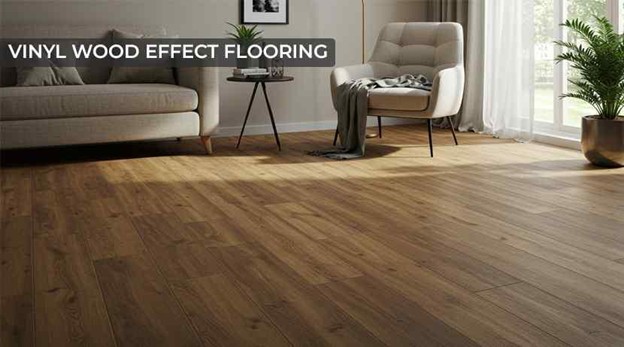
Stone Effect Vinyl Flooring
If you love the elegance and look of porcelain or stone but you do not have the budget or do not want your floor cold, vinyl tiles stone effect provide the same visual depth while remaining soft underfoot. Stone effect vinyl tiles enhance minimalistic interiors without the slipperiness of real tiles.
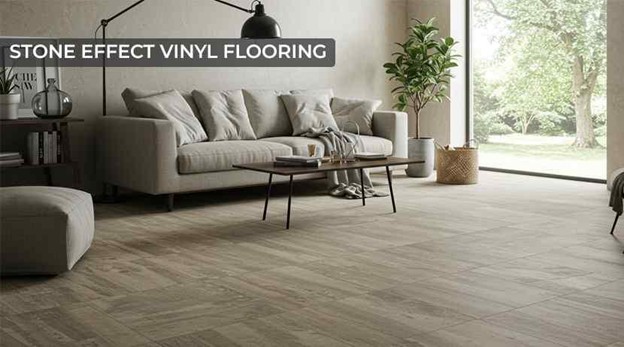
Pro-Tip: Use stone-patterned vinyl in your living room and real stone-effect floor tiles in entryways for a seamless design palette.
Patterned Vinyl Flooring
As a fan of mid-century modern or realtor aesthetics, patterned vinyl for floors can be a bold statement. Moroccan-style tiles or geometric features can be used as accent zones around seating or media areas to introduce interest without dominating the whole space.
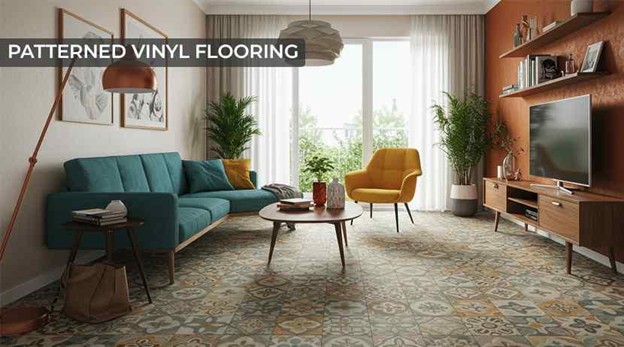
For more luxury vinyl floor designs, read more here: Different Designs of Luxury Vinyl Floor Tiles for Your Home
Luxury Vinyl Flooring Layouts
Wide-Planks
Use 1800mm vinyl planks to elongate small rooms and reduce seam visibility. Keep grout lines minimal for a flush and expansive look.
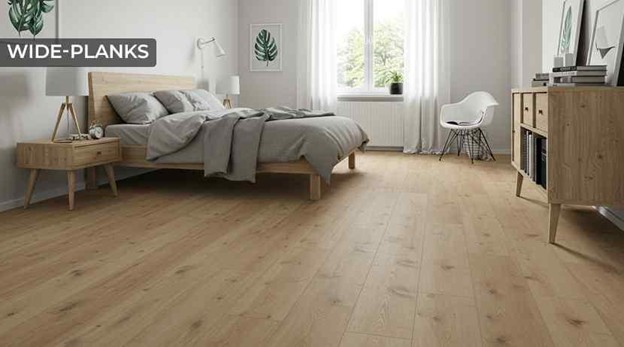
Vinyl Herringbone Flooring
LVT flooring Herringbone or Chevron, is ideal for larger living rooms. They offer architectural flair. Although they are slightly more complex to install, the visual depth justified the effort.
Herringbone pattern in luxury vinyl click systems is more manageable.
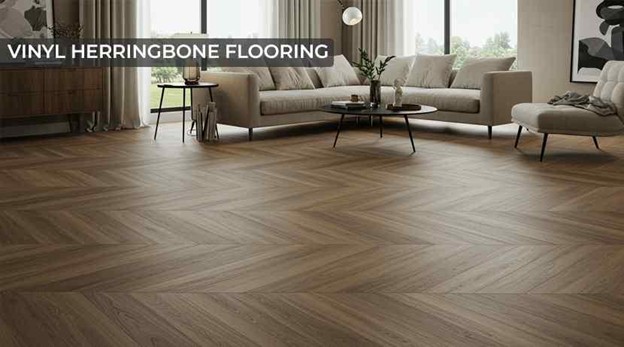
Zig-Zag Border
Frame your sofa or TV border with a border pattern using a darker vinyl flooring tile effect to zone the space. This creates defined areas without using physical barriers.
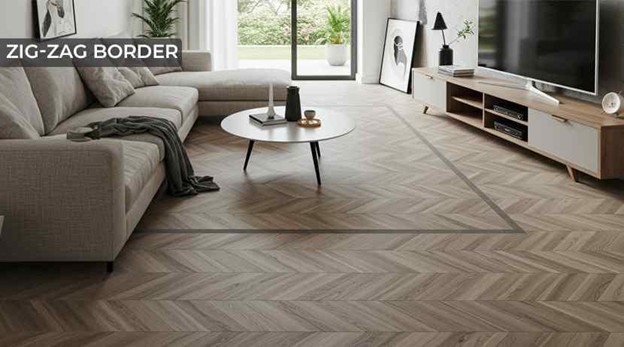
Comfort And Acoustics
Vinyl flooring tiles cushioning enhances comfort, allowing you to lounge barefoot. Many of the flooring LVT options have acoustic backing that reduces noise, which is ideal for London flats or multi-level homes. To improve performance further, choose models with thicker cork or foam layers. Underfloor heating integration goes very well with vinyl, unlike carpet, which dampens the heat.
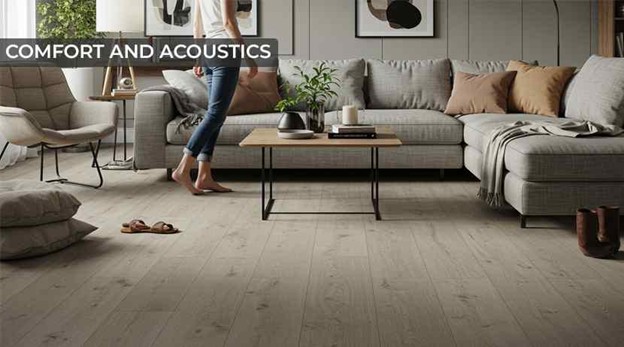
Blending Vinyl and Floor Tiles
You can elevate your space by trying these seamless combos:
- Pairing Stone-effect vinyl with porcelain floor tiles in adjacent areas.
- Use realistic stones or tile lookalikes in your kitchen or hallways in order to tie them with your vinyl floors in the living room.
- Position your vinyl flooring planks in main zones and transition to premium floor tiles in entryways using smooth trims.

Best Vinyl Colour and Texture Ideas

We recommend you use:
- Hearth neutrals like Oak, stone, grey, or soft beige to balance against the walls and textiles.
- Cool grays like Chateau Grey herringbone click vinyl floor tiles and dark charcoals are also an optimal choice, offering modern sophistication. You can pair it with beautiful, vibrant accent furniture.
- For a warmer and welcoming space, use wood tones with natural grains along with minimal decor items in the area.
- Go for embossed grain textures for tactile depth underfoot.
Lighting, Accessories, and Rugs
Lights are the perfect elements to bring out the earthy tones in your space. Add candles, lanterns, fairy lights, or solar LED lights to warm up your living room.
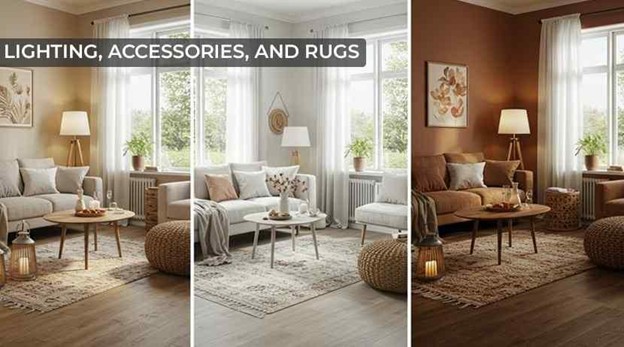
Add textured rugs to divide your area into natural zones, like your seating area. This will not only provide more comfort but also soften the overall look of your living room.
You can also coordinate your LVT vinyl flooring undertones with the wall paint or soft furnishings to enhance the cohesion of your living room. Using this technique, you will tie your living room together.
Vinyl Vs Other Materials
Let’s compare alternatives mostly used in the living room other than LVT flooring:
Vinyl Vs Carpet
Vinyl is resistant to allergens, stains, and dust mites, and is much more pet-friendly than carpets. They are perfect for people who suffer from allergies or for children.

Vinyl vs Hardwood or Engineered Wood
Vinyl, unlike hardwood, avoids warping from drying. They are more water-resistant, do not swell due to moisture, and are considerably cheaper than wood options.
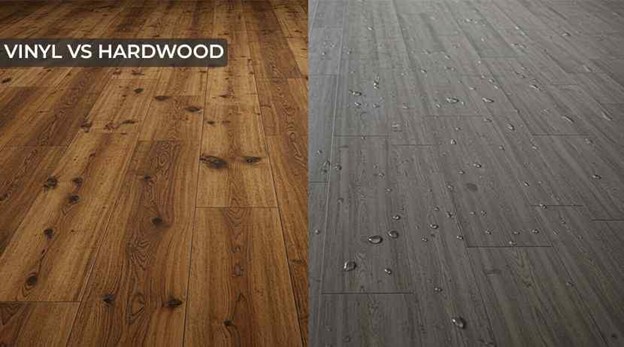
Vinyl vs Porcelain Tiles
Vinyl is soft and quieter while offering a similar visual appeal to porcelain. They are ideal for cosy living rooms.
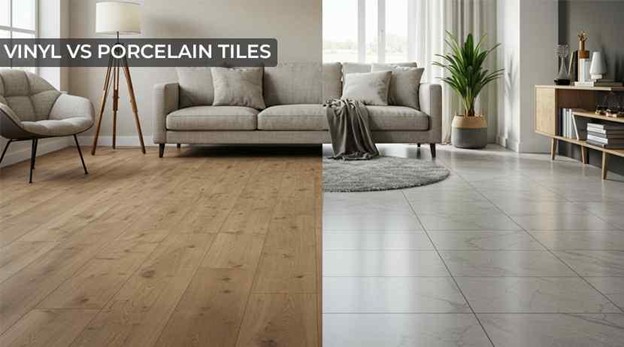
Conclusion
The living room is one of the most prominent spaces in your house where you make memories with your loved ones during holidays like Christmas or every other evening. It should reflect that required warmth.
Quality-wise, the best vinyl flooring offers a perfect blend of comfort, design, and durability for the UK living rooms. Whether you want to go for wooden tones, stone textures, or bold patterns, vinyl is versatile enough to tailor it to any interior design.
Pair affordable vinyl flooring seamlessly with any floor tiles from Royale Stones to link your different indoor areas harmoniously. They provide the best Vinyl flooring options and porcelain tiles to make your living room a haven of your own!
Frequently Asked Questions
Q: Is vinyl flooring suitable for a living room?
A: Yes. Vinyl floors offer great comfort underfoot. They also have great aesthetic variety and practicality. They are resistant to stains and scratches, which is ideal for family living rooms.
Q: What is the downside of vinyl flooring?
A: Vinyl can be penetrated and pierced with sharp or heavy objects. They may fade if exposed to direct sunlight. The low-grade vinyl options may last 5 to 10 years.
Q: What is the best flooring for a living room?
A: It all depends on personal style and budget, but vinyl competes closely with timber and carpet. They combine affordability, durability, and easy upkeep.
Q: Is vinyl better than carpet in a living room?
A: Yes. Vinyl tiles are more hygienic, withstand spills better, and do not trap allergens. They feel cooler underfoot, but the areas that have rugs can provide comfort.
Q: What is the life expectancy of vinyl flooring?
A: Standard to high-quality vinyl flooring lasts around 10 to 20 years. Premium vinyl with thicker wear layers can extend to 25+ years.
